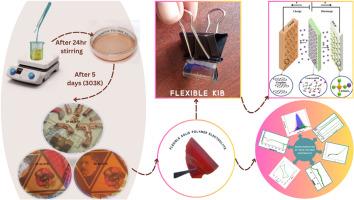Advanced eco-conscious amylaceous biopolymer electrolytes functionalized with potassium iodide for high-performance flexible potassium-ion batteries
IF 7.9
2区 工程技术
Q1 CHEMISTRY, PHYSICAL
引用次数: 0
Abstract
Solid biopolymer electrolytes (SBEs) based on cornstarch and potassium iodide (KI) have been developed via solution casting, demonstrating enhanced safety and flexibility for potassiumion batteries (KIBs). X-ray diffraction has been confirmed KI reduced semicrystallinity, while Fourier transform infra-red spectroscopy (FTIR) revealed cation interactions with C‒O band, yielding 75.19 % free ions. Moreover, 70/30 (cornstarch/KI) composition achieved optimal ionic conductivity (2.50 × 10−4 S/cm at 303K) with minimal activation energy (0.13 eV). Theoretical modelling validated the Overlapping Large Polaron Tunnelling and Small Polaron Hopping models accurately describe ion conduction, specifically at mid and high frequency ranges. Dielectric analysis showed an exceptional dielectric constant of 7.86 × 106 at 42 Hz. A negative dielectric constant of −273.897 emerges at 1 MHz due to the prevailing inductive response in this frequency range. The SBE exhibited a high ion transference number (0.98) and ultrafast relaxation (1.01 μs). A flexible KIB delivered an open-circuit voltage of 1.085 V, showcasing its potential for next-generation energy storage.

先进的生态意识淀粉类生物聚合物电解质功能化的高性能柔性钾离子电池的碘化钾
基于玉米淀粉和碘化钾(KI)的固体生物聚合物电解质(SBEs)已经通过溶液铸造开发出来,证明了钾离子电池(kib)的安全性和灵活性。x射线衍射证实KI降低了半结晶度,傅里叶变换红外光谱(FTIR)显示阳离子与C-O波段相互作用,产生75.19%的自由离子。此外,70/30(玉米淀粉/KI)的组合以最小的活化能(0.13 eV)获得了最佳的离子电导率(在303K时为2.50 × 10−4 S/cm)。理论模型验证了重叠的大极化子隧穿和小极化子跳变模型准确地描述了离子传导,特别是在中高频范围内。介电分析表明,在42 Hz时介电常数为7.86 × 106。由于该频率范围内普遍存在的感应响应,在1 MHz处出现负介电常数- 273.897。SBE具有高离子转移数(0.98)和超快弛豫(1.01 μs)。灵活的KIB提供了1.085 V的开路电压,展示了其下一代储能的潜力。
本文章由计算机程序翻译,如有差异,请以英文原文为准。
求助全文
约1分钟内获得全文
求助全文
来源期刊

Journal of Power Sources
工程技术-电化学
CiteScore
16.40
自引率
6.50%
发文量
1249
审稿时长
36 days
期刊介绍:
The Journal of Power Sources is a publication catering to researchers and technologists interested in various aspects of the science, technology, and applications of electrochemical power sources. It covers original research and reviews on primary and secondary batteries, fuel cells, supercapacitors, and photo-electrochemical cells.
Topics considered include the research, development and applications of nanomaterials and novel componentry for these devices. Examples of applications of these electrochemical power sources include:
• Portable electronics
• Electric and Hybrid Electric Vehicles
• Uninterruptible Power Supply (UPS) systems
• Storage of renewable energy
• Satellites and deep space probes
• Boats and ships, drones and aircrafts
• Wearable energy storage systems
 求助内容:
求助内容: 应助结果提醒方式:
应助结果提醒方式:


